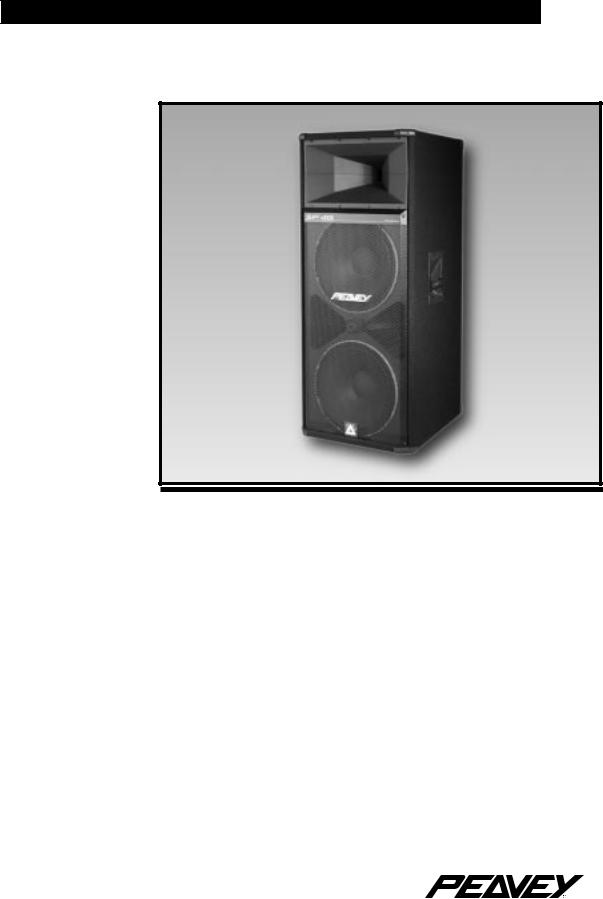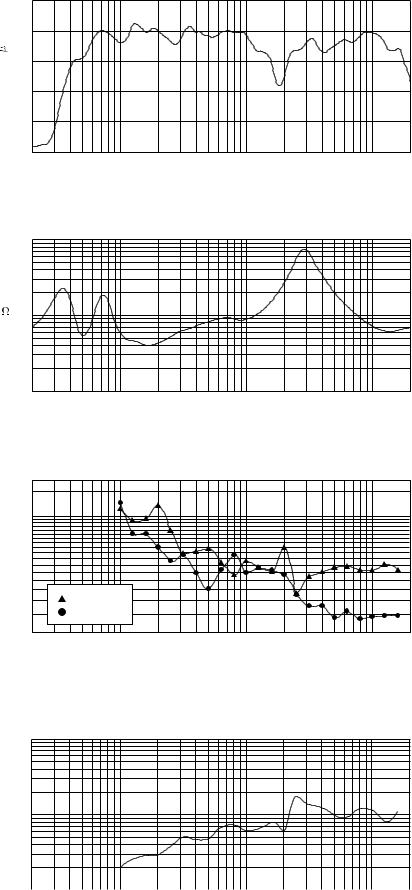Peavey SP 4G User Manual

SPECSP E A V E Y E L E C T R O N I C S
SP™ 4G
Sound Reinforcement Enclosure with Sound Guard™ HF Protection System
SPECIFICATIONS
Frequency Response, 1 Meter
On-Axis, Swept-Sine in Anechoic
Environment:
50 Hz to 17.5 kHz
Low Frequency Cut-Off (-3 dB point):
50 Hz
Usable Low Frequency Limit (-10 dB point):
39 Hz
Power Handling:
Full Range:
600 W continuous (49.0 V RMS)
1,200 W program
2,400 W peak
Bi-amp Low:
700 W continuous (52.9 V RMS)
1,400 W program
2,800 W peak
Bi-amp High:
40 W continuous (17.9 V RMS)
80 W program
160 W peak
Sound Pressure Level, 1 Watt, 1
Meter in Anechoic Environment:
Full Range: |
100 dB (2.0 V) |
Bi-amp Low: |
100 dB (2.0 V) |
Bi-amp High: |
106 dB (2.8 V) |
Maximum Sound Pressure Level (1 meter):
Full Range:
127 dB continuous
133 dB peak
Bi-amp Low:
128 dB continuous
134 dB peak
Bi-amp High:
122 dB continuous
128 dB peak
Radiation Angle Measured at -6 dB
Point of Polar Response:
1.6 kHz to 5 kHz:
Horizontal: 83° ±19° Vertical: 57° ±17°
5kHz to 16 kHz: Horizontal: 86° ±3°
Vertical: 39° ±2°
Directivity Factor, Q (Mean):
9.5 ±3.3
Directivity Index, Di (Mean):
9.5 dB ±1.5 dB
Transducer Complement:
Two 1505-8 KADT Black Widow® woofers
One 22XT™ compression driver loaded by a CH® 941 horn
Box Tuning Frequency:
50 Hz
Crossover Frequency (internal passive):
1.8 kHz
Minimum Recommended Active Crossover Frequency and Slope for Bi-amping:
1.2 kHz at 18 dB/octave
Time Offset:
Impedance (Z):
Full Range Nominal: 4 Ω
Full Range Minimum: 3.9 Ω
Lows Nominal: 4 Ω
Highs Nominal: 8 Ω
Input Connections:
Two paralleled 1/4" phone jacks for full-range input
One 1/4" phone jack for bi-amp low frequency input
One 1/4" phone jack for bi-amp high frequency input
Enclosure Materials and Finish:
3/4" plywood enclosure covered with black carpet and protective polymer corners
Expanded metal grille to protect the low frequency driver
Mounting Provisions:
None
Dimensions (H x W x D):
49.25" x 21.50" x 22.75"
(125.1 cm x 54.6 cm x 57.8 cm)
500 Hz to 1.6 kHz: |
0.70 mS (delay Lows) |
|
Horizontal: 92° ±13° |
||
|
||
Vertical: 83° ±13° |
|

Net Weight:
135 lbs. (61.4 kg)
FEATURES
•Two 1505-8 KADT Black Widow® woofers
•22XT™ compression driver
•Sound Guard™ high frequency protection circuit
•Trapezoidal enclosure design
•Built-in pocket casters for easy movement
DESCRIPTION
The redesign of the ever popular SP™ 4 has resulted in the SP™ 4G loudspeaker system. It is a pseudo three-way speaker system comprised of a 15" Scorpion® Plus woofer with a Kevlar® impregnated cone and a 22XT™ compression driver coupled to a CH® 941 constant directivity horn.
This unit can be driven in full-range or bi-amp mode simply by plugging into the desired jack on the input plate. The SP™ 4G has a trapezoidal shaped box, rather than a rectangular shaped box, that allows arrays to be constructed much more easily. This shape also greatly reduces the build-up of standing waves on the inside of the enclosure. This ensures a minimum of mid-bass and mid-range coloration of the reproduced sound due to the cabinet. The SP™ 4G is constructed of 3/4" plywood and is covered with Peavey’s durable black carpet. Polymer corners are also a part of the unit to provide added protection to the enclosure. A powder-coated, expanded metal grille covers the lower part of the front of the enclosure to protect the low frequency driver from unforeseen accidents.
Sound Guard™, Peavey’s proprietary circuit for high frequency driver protection, has been included as an integral part of the crossover for the SP™ 4G. The input signal is routed through the Sound Guard™ circuit in both full-range and bi-amp modes of operation. When the high frequency drive level to the SP™ 4G exceeds a predetermined threshold the Sound Guard™ circuit in engaged. This subtly decreases the signal level going to the 22XT™ so that it will not be damaged due to long-term overpowering. Short duration transients will not be attenuated by Sound Guard™ and have the possibility to damage the 22XT™. The Sound Guard™ circuit is a dynamic circuit that will attenuate the signal more in relation to how large the signal is, very similar to a compressor. This is accomplished through the use of a specially selected, dynamically resistive
|
|
Amplitude Response |
(1W 1m On-Axis) |
|
||||||
|
110 |
|
|
|
|
|
|
|
|
|
Pa) |
100 |
|
|
|
|
|
|
|
|
|
|
|
|
|
|
|
|
|
|
|
|
20 |
90 |
|
|
|
|
|
|
|
|
|
(re |
|
|
|
|
|
|
|
|
|
|
dB SPL |
80 |
|
|
|
|
|
|
|
|
|
70 |
|
|
|
|
|
|
|
|
|
|
|
|
|
|
|
|
|
|
|
|
|
|
60 |
50 |
100 |
200 |
500 |
1k |
2k |
5k |
10k |
20k |
|
20 |
|||||||||
|
Figure 1 |
|
|
|
Frequency (Hz) |
|
|
|
|
|
|
|
|
|
|
|
|
|
|
|
|
|
|
|
|
|
Impedance |
|
|
|
|
|
|
100 |
|
|
|
|
|
|
|
|
|
|
50 |
|
|
|
|
|
|
|
|
|
|
30 |
|
|
|
|
|
|
|
|
|
Z 20 |
|
|
|
|
|
|
|
|
|
|
( |
) 10 |
|
|
|
|
|
|
|
|
|
|
5 |
|
|
|
|
|
|
|
|
|
|
3 |
|
|
|
|
|
|
|
|
|
|
2 |
|
|
|
|
|
|
|
|
|
|
1 |
50 |
100 |
200 |
500 |
1k |
2k |
5k |
10k |
20k |
|
20 |
|||||||||
|
Figure 2 |
|
|
|
Frequency (Hz) |
|
|
|
|
|
|
|
|
|
|
|
|
|
|
|
|
|
360 |
|
|
|
Beamwidth |
|
|
|
|
|
|
|
|
|
|
|
|
|
|
|
|
|
300 |
|
|
|
|
|
|
|
|
|
(Degrees) |
180 |
|
|
|
|
|
|
|
|
|
140 |
|
|
|
|
|
|
|
|
|
|
|
|
|
|
|
|
|
|
|
|
|
Beamwidth |
100 |
|
|
|
|
|
|
|
|
|
80 |
|
|
|
|
|
|
|
|
|
|
60 |
Horizontal |
|
|
|
|
|
|
|
||
|
|
|
|
|
|
|
|
|||
|
40 |
Vertical |
|
|
|
|
|
|
|
|
|
30 |
50 |
100 |
200 |
500 |
1k |
2k |
5k |
10k |
20k |
|
20 |
|||||||||
|
Figure 3 |
|
|
|
Frequency (Hz) |
|
|
|
|
|
|
|
|
|
|
|
|
|
|
|
|
|
Q & Directivity Index |
100 |
20 |
Q |
Di |
10 |
10 |
1 |
|
|
|
|
|
|
|
|
|
|
0 |
|
50 |
100 |
200 |
500 |
1k |
2k |
5k |
10k |
|
||
20 |
20k |
||||||||||
Figure 4 |
|
|
|
Frequency (Hz) |
|
|
|
|
|
||
|
|
|
|
|
|
|
|
|
|
||
